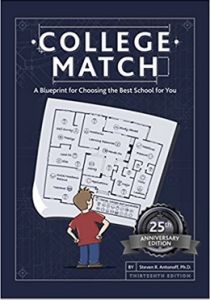Trying to build a college application list can feel like having to find your keys in the dark. How do you know which direction to jump? And – horror of horrors – what happens if you inadvertently overlook the student’s “dream school”?
Building the “right fit” college application list involves two goals:
- Finding colleges that align with the student’s interests (both academic and community) while challenging them to grow intellectually and emotionally
- Including a mix of “reach,” “attainable,” and “safety” schools.
There are six steps to finding the “right fit”:
-
-
- Debunking myths. Here are the realities…. Every student has choices – not just top students. The “best” schools might not be the right fit for a particular student. What matters is that you get the diploma, not where the diploma is from. Colleges “shape” their freshman classes using a number of different variables – not just grades.
- Think outside the box. If you’re interested in a debt-free education, you need to get creative. Private schools, out-of-state schools, international schools, and Historically Black Colleges and Universities (HBCUs) can offer great value. Find schools where the student will be a big fish in a small pond; they’ll be more attractive to and attract more institutional scholarships.
- Determine your priorities. When building the list of schools to which you’d like to apply, think about differences between types of colleges and how significant those differences are to you. Look at geographic setting, number of students, gender balance, ethnic diversity, Greek life, LGBTQ+ friendliness, athletics, religious affiliation, financial aid, four-year graduation rates, political leanings. Prioritize which factors are important to you.
- Research colleges. Rely on college websites, high school counselors, college recruiters, college visits, and college fairs to gather information about various colleges.
- Make your list of colleges. Your list should include a mix of “reach,” “attainable,” and “safety” schools. All schools should be places that are a good fit for the student, places the student wants to go, and places where the student meets the course requirements. Reach schools are those where the student’s unweighted GPA and test scores are aligned with the average of last year’s admitted freshman class. Attainable schools are those where GPA and scores are above last year’s class. Safety schools are those where GPA and scores are well above last year’s class.
- Get on their radar. Colleges want to attract students who really want to attend. How do they know who wants to attend? By something called “demonstrated interest.” You can demonstrate interest by providing your information to representatives at college fairs, requesting information on college websites, and by calling the admissions office and asking questions. You can email the college, register to go on a college tour, and open the emails that colleges send you.
-
Links and Resources
Various College Ranking Lists
When building your “right fit” college list, consider which factors are most important to you. Here are links to various college lists:
U.S. News & World Report’s list of most and least ethnically diverse U.S. universities
Hispanic Association of Colleges & Universities’ list of 300 Hispanic-Serving Institutions (HSIs)
Money Magazine & Sports Illustrated’s list of colleges. Criteria: affordability, excellence, career outcomes, athletic opportunities, and fan experience
Council for Christian Colleges and Universities directory of colleges
U.S. Conference of Catholic Bishops lists Catholic colleges
U.S. News and World Report’s list of colleges that meet 100% of financial need
Princeton Review’s list of 20 colleges with the best Greek life (sororities and fraternities)
Campus Pride Index’s database of LGBTQ-friendly campuses

Best DIY Book
“College Match,” by Steven Antonoff is the single best all-in-one resource we’ve come across for building a college application list. Here’s a review written by Sally: https://www.scholarshipmoneyonline.com/college-list-college-match/
Antonoff has excellent downloadable worksheets in both English and Spanish on his website, http://schoolbuff.com/. Go to the dropdown menu under the “Writing” tab, and then to “College Planning Worksheets.”
Do You Have Elite Institution Cognitive Disorder?
If you or your student is convinced that the student must go to an Ivy League or super-elite school, it’s worth spending 19 minutes to watch Malcolm Gladwell’s presentation to Google. He makes the case that the student who is a “big fish in a small pond” can be more successful (and, arguably, happier) than one who attends an elite university.
Want more info and tips about college? Subscribe to the Scholarship Money Online newsletter.



Leave A Comment